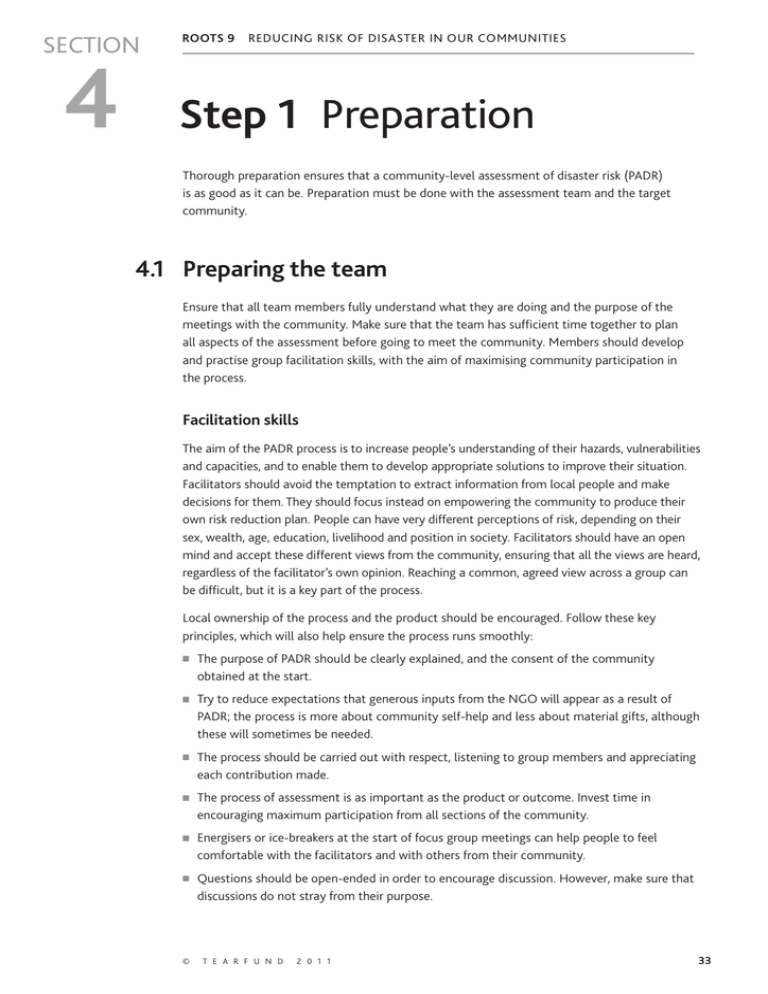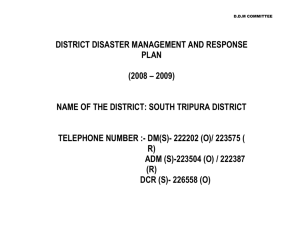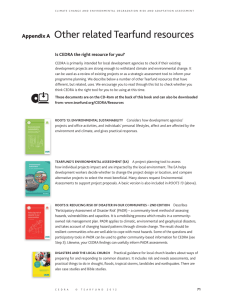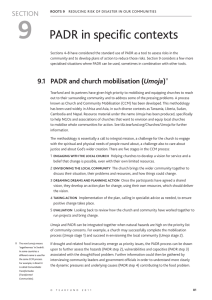4 Step 1 SECTION
advertisement

SECTION 4 ROOTS 9 REDUCING RISK OF DISASTER IN OUR COMMUNITIES Step 1 Preparation Thorough preparation ensures that a community-level assessment of disaster risk (PADR) is as good as it can be. Preparation must be done with the assessment team and the target community. 4.1 Preparing the team Ensure that all team members fully understand what they are doing and the purpose of the meetings with the community. Make sure that the team has sufficient time together to plan all aspects of the assessment before going to meet the community. Members should develop and practise group facilitation skills, with the aim of maximising community participation in the process. Facilitation skills The aim of the PADR process is to increase people’s understanding of their hazards, vulnerabilities and capacities, and to enable them to develop appropriate solutions to improve their situation. Facilitators should avoid the temptation to extract information from local people and make decisions for them. They should focus instead on empowering the community to produce their own risk reduction plan. People can have very different perceptions of risk, depending on their sex, wealth, age, education, livelihood and position in society. Facilitators should have an open mind and accept these different views from the community, ensuring that all the views are heard, regardless of the facilitator’s own opinion. Reaching a common, agreed view across a group can be difficult, but it is a key part of the process. Local ownership of the process and the product should be encouraged. Follow these key principles, which will also help ensure the process runs smoothly: ■ The purpose of PADR should be clearly explained, and the consent of the community obtained at the start. ■ Try to reduce expectations that generous inputs from the NGO will appear as a result of PADR; the process is more about community self-help and less about material gifts, although these will sometimes be needed. ■ The process should be carried out with respect, listening to group members and appreciating each contribution made. ■ The process of assessment is as important as the product or outcome. Invest time in encouraging maximum participation from all sections of the community. ■ Energisers or ice-breakers at the start of focus group meetings can help people to feel comfortable with the facilitators and with others from their community. ■ Questions should be open-ended in order to encourage discussion. However, make sure that discussions do not stray from their purpose. © T E A R F U N D 2 0 1 1 33 4 STEP 1 Preparation ROOTS 9 REDUCING RISK OF DISASTER IN OUR COMMUNITIES ■ Literacy should not be assumed. Participatory tools enable people who are not literate to participate in information gathering and analysis; hand-drawn pictures or locally taken photos can also be very helpful. ■ Sensitive issues should be dealt with carefully and appropriately. Show sympathy and compassion if people are describing painful experiences from the past. ■ Find out beforehand if there have been recent disputes in the community, especially over natural resources. Check the wording of the questions to ensure they will not revive a past conflict. It may be better not to discuss a disputed issue in the group, but to ask key informants instead. Here are some more tips on good facilitation: Top tips on group facilitation DO DON’T allow time for introductions and explanations teach show respect for all views/opinions rush through process at speed watch, listen, learn and show interest lecture be sensitive to feelings and culture criticise contributions be prepared, but flexible interrupt speakers be creative dominate discussions show humour look bored be willing to allow community members to take the lead ignore cultural norms finish well, with thanks to everyone and agreement on the next step of process laugh at people’s ideas use mobile phones Participation PADR is based on a participatory approach, to ensure that all voices from the community are heard. The more vocal members of the community or the leaders often tend to dominate the group work. The team must ensure that every individual in the various groups is given opportunity to express their valuable opinion, which is eventually incorporated into the community disaster risk management plan. There are a few simple ways of achieving this – for example, if a few members dominate, thank them for their contribution but specifically ask quieter members for their contribution too. If all speak at once, introduce a stick (or other suitable object) into the discussion. This object is given to the speaker – who hands it on to the next speaker; only the person holding the stick may speak. The presence of a community leader may discourage other members of the group from expressing their opinions. One way to avoid this problem is to arrange a separate interview with the leader(s) in a different place. 34 T E A R F U N D R O O T S R E S O U R C E S 4 STEP 1 Preparation ROOTS 9 REDUCING RISK OF DISASTER IN OUR COMMUNITIES 4.2 Participatory tools Several participatory tools are available for use in community discussions about disaster risk. The tools give an opportunity for more people to get involved and often lead to helpful conversations about solutions as well as about the problems. It is a good idea to use tools such as mapping, ranking and seasonal calendars with separate male and female groups, as their perception of risks and priorities may be different. How to use participatory tools TOOL WHICH PADR STEPS? PURPOSE Community mapping Step 2: Hazard assessment To show buildings, structures and natural resources Step 3: Vulnerability and capacity assessment To show areas and resources affected by the hazard Step 5: Risk management plans To show the capacities – things which are unaffected by the hazard The two following pages explain each tool in more detail, and include more tools which may also be useful To identify safe areas and define safe evacuation routes for contingency plans Ranking Step 2: Hazard assessment Step 3: Vulnerability and capacity assessment Step 5: Risk management plans To determine which hazard or which impact of the hazard is of most significance to community To show which natural resources are most important To help people agree on which vulnerability is a priority and should be addressed first in planning Timeline Step 2: Hazard assessment To show the history of local disaster events To identify any changes or trends in hazard type, frequency or intensity, giving clues for the future Seasonal calendar Step 2: Hazard assessment Step 3: Vulnerability and capacity assessment Step 5: Risk management plans Venn diagram Step 3: Vulnerability and capacity assessment Step 5: Risk management plans To show the specific times of year when hazards and livelihood activities occur, and which activities are most at risk To show the safer seasons of the year, which should be used to the full for agriculture and other livelihoods To give a visual representation of the various social groups, demonstrating their relative importance and relationships between them To identify under-used groups which have capacities To identify groups which may need to be influenced to bring about change to a structure or a process affecting the community (a dynamic pressure) Transect walk © Step 3: Vulnerability and capacity assessment T E A R F U N D 2 0 1 1 To gather additional information about the capacities and vulnerabilities in the community 35 STEP 1 Preparation ROOTS 9 TIMELINE REDUCING RISK OF DISASTER IN OUR COMMUNITIES HIGH This is used to gather information about disasters which have occurred in the past and to predict the possible disasters of the future, using visible trends. The height of the dotted line above the baseline shows how severe the hazard was. Earthquake Houses damaged One in 2O people killed SEVERITY OF HAZARD 4 Locust infestation Crops destroyed Severe drought Wells dried up Loss of livestock Crop failure People migrate to camps Drought Drought Flash flood LOW 2005 2006 2007 2008 2009 2010 2011 YEAR TRANSECT WALK This is a planned walk through the area to observe different land uses, buildings, economic activities and natural resources. Ask questions and make notes. Seek permission before taking photographs. RANKING Ranking is a tool used to choose which hazard, impact or intended activity is of highest priority to a group of people. Ranking allows every member of a group to express their own opinion. Each person’s vote is equally important. Ranking can be done by writing or drawing the choices onto separate pieces of paper or by drawing on the ground. Each individual is given six stones (or seeds or bottle caps) and has to allocate them according to their priority. They should put three stones on their first choice, two on their second and one on their third choice. In the picture below, group members have voted to determine which hazard has the biggest impact on them. A variation of this method is to write or draw the choices onto four paper bags. Voting proceeds as before, placing stones inside the bag of choice. This is useful when you want the voting to be secret. Another method is to write or draw the choices onto cards, lay the cards out and ask the group to prioritise the cards by moving them around, putting the highest priority at the top. FLOOD EARTHQUAKE FIRE TSUNAMI FOLK SONGS, STORIES, POETRY Ask the community if they have any traditional songs, stories, poems or sayings about disasters. These can reveal indigenous knowledge, beliefs and practices. 36 T E A R F U N D R O O T S R E S O U R C E S 4 ROOTS 9 STEP 1 Preparation REDUCING RISK OF DISASTER IN OUR COMMUNITIES VENN DIAGRAM This shows the social groups and organisations in the community, the relative size and influence of the groups and the relationships between them. Chief Traditional healers School Paul Venton / Tearfund Elders Church Development committee Football team Women’s group Map drawn by women in Banda Aceh. Farmers’ cooperative Clinic Forestry department Police post MAPPING Government Agriculture Department DRAMA Community members might be able to act out what happens during a disaster using drama or mime. Useful sketches for emphasising participation are available in other Tearfund resources and on tilz (for example ‘Crossing the river’ and ‘Lighting the fire’ from the PILLARS Guide Mobilising the community). This involves drawing the main features and landmarks of the community as a map. The map should include houses, community facilities, roads, bridges and natural resources. Mark the area which is affected by hazards and the location of key resources in an emergency. Maps can be drawn on the ground with sticks, stones, leaves etc, or with chalk on a blackboard, or with marker pens on large sheets of paper. SEASONAL CALENDAR This shows when hazards occur and when livelihood activities and other significant events take place. It shows the activities which are most at risk and the ‘safe’ seasons. Use the local calendar months if possible. Jan Feb Mar Apr May Jun Jul Aug Sep Oct Nov Dec Hazard Flood Landslide Malaria Ploughing Activities Planting rice Weeding Rice harvest Vegetables Migration Handicrafts © T E A R F U N D 2 0 1 1 37 4 STEP 1 Preparation ROOTS 9 REDUCING RISK OF DISASTER IN OUR COMMUNITIES 4.3 Preparing for the focus group discussions and interviews Focus group discussions are the most significant part of the PADR exercise, allowing the team to enter into a detailed discussion about local hazards, vulnerabilities and capacities. The process relies on a combination of questionnaires and participatory tools – see above. Focus groups should be arranged in advance, and made up of 12–15 people. At least two groups are needed (one male, one female), but in a larger, diverse community, other groups can be set up to allow minorities or marginalised groups to have a greater voice. Possibilities include: ■ elderly people ■ young people and children ■ livelihood groups ■ existing committees or social groups such as women’s savings and credit groups or male farmers’ clubs ■ minority ethnic or religious groups These different groups will each have different perspectives on the community and different understandings of their hazards, vulnerabilities and capacities. Mixed groups are not a good idea, as those regarded as more senior or more powerful will dominate the discussions. The facilitator and his/her team should prepare and fully understand the questions they will ask in the group. It might also be necessary to have a translator, and to think about appropriate ways of asking questions in a local language. The facilitator should carry these prepared questions, but should also be flexible to listen and respond to what the community are saying. The questions need to be adapted to each context to ensure that they are relevant to the local situation and the predominant disaster type. Examples of questions that could be used in the focus group discussions are in Appendix A (page 87). The participatory tools also need to be well planned. Before going into the community, the team should decide which tools they are going to use and when they will use them. Essential items such as paper, marker pens and small stones should be gathered and carried by the team. It is recommended that each focus group discussion should take at least one hour, but not more than two hours, otherwise people start to lose interest. Each group should meet at least three times to cover all the topics that need to be discussed as part of the PADR process. Some thought should be given to refreshments, which can be shared with the focus group members, for example, popular local snacks, sweets or cartons of drink. Similar food/drink should be taken by team members. As well as the focus group discussions, PADR involves interviews with those in leadership or with influence in the community. They are called key informants and include: 38 T E A R F U N D R O O T S R E S O U R C E S STEP 1 Preparation ROOTS 9 REDUCING RISK OF DISASTER IN OUR COMMUNITIES Bob Hansford / Tearfund 4 A men’s focus group in Assam, India, draws a map of the community on the ground using sticks, stones and seeds. ■ government officials ■ community leaders ■ school teachers / head teachers ■ medical personnel ■ women’s group leaders ■ religious leaders ■ UN workers ■ other NGO staff Part of the preparation is to identify suitable people in the community and arrange meetings at convenient times and places. Remember that the key informants will also have their own perspectives and experience, and may have personal interests to pursue. The information received from these individuals should always be compared with what the focus groups say, so that the facilitation team understands as fully as possible the issues within the community. Ideally, the key informants should not belong to focus groups, as they may direct and dominate the group. If there are enough team members, it may be possible to carry out an interview while others run the focus group. Examples of suitable questions for key informants are given in Section 7.3. © T E A R F U N D 2 0 1 1 39 4 STEP 1 Preparation ROOTS 9 REDUCING RISK OF DISASTER IN OUR COMMUNITIES 4.4 Team roles and responsibilities Allocate different roles to the team members so everyone is clear what they should be doing. Consider inviting a local staff member or community representative (eg a teacher) to be a member of the team. Suggested roles are: LEAD FACILITATOR Responsible for directing the discussions by asking the questions and moving the conversation on to new topics when necessary. The facilitator should be very clear on the whole process, maintaining direction and momentum. He or she should have experience of facilitating groups. ASSISTANT FACILITATOR (OR TRANSLATOR IF REQUIRED) Helps the lead facilitator where necessary, eg rewording questions if they are unclear, or helping to organise the participatory tools. NOTE-TAKER (OR RECORDER) Responsible for writing down the answers to the questions and keeping copies of any maps, seasonal calendars, Venn diagrams or ranking exercises. LOGISTICS COORDINATOR Responsible for making the practical arrangements with the community, including times and places, equipment, chairs or mats, and drinks. He/she should also be responsible for timekeeping in the meetings. 4.5 Other sources of information Other sources of information about the area may be available. For example, local government statistics, meteorological data, local CBOs’ or NGOs’ records, reports and evaluations could all be useful. Scientific data might be available from local universities or from websites. It will take some time to find relevant information from these sources but it is very worthwhile, helping to build an accurate picture of the community and the risks they face. It is good to involve local government officials in the process from the beginning. They should be able to provide official data, on population and on previous disasters, for example, and they will be key informants about government policies and programmes. 4.6 Preparing the community A plan to carry out PADR must be developed in consultation with the community, particularly its leaders. Their understanding and ownership of the process is very important for a successful assessment and implementation of a risk management plan. It is also important to gain as much support from the government as possible, and of course any relevant permission that is required. Expectations The purpose of PADR must be clearly explained, so that the community develops realistic expectations of the PADR process. Some communities have a relief-dependent attitude, particularly in post-disaster situations when much food aid has been distributed. The facilitators need to emphasise that PADR is about identifying community capacities as well as 40 T E A R F U N D R O O T S R E S O U R C E S 4 STEP 1 Preparation ROOTS 9 REDUCING RISK OF DISASTER IN OUR COMMUNITIES vulnerabilities. Ownership of the process and the various maps, tools and action plans should remain with the community. The process is not the same as a needs assessment exercise leading to NGOs providing materials or resources for the community. Timing and location of focus groups A suitable time for each focus group must be arranged, avoiding clashes with farm work or meal preparation. Make every effort to find a convenient time that fits with the daily schedule of group members. Ensure that a suitable day is agreed, avoiding days of markets, festivals or marriages. It is good to find a place to meet where people feel comfortable, that is relatively quiet and where there is enough space. Meetings should preferably be outside in the shade, but with a degree of privacy also. Expect women’s groups to have young children present, so make it easy for mothers to attend to the needs of babies. Checklist Have you completed all the steps in the following checklist before going out to the community? Necessary arrangements made in the community for focus group meetings and key informants (time, place, people invited etc) ✓ Transport and refreshments arranged ✓ Team trained and competent in group facilitation and participatory tools ✓ Team roles allocated and members clear about the purpose of meetings ✓ Team have question sheets prepared and know how to ask the questions in the local language or dialect ✓ Arrangements for translation have been made if required ✓ Materials assembled for participatory tools (flip chart, markers, stones etc) ✓ Information collected from secondary sources ✓ 4.7 PADR and gender It is important that the issue of gender is sensitively and comprehensively addressed throughout the risk assessment process. This is necessary not only to ensure that women’s vulnerabilities and capacities are adequately determined, but also to ensure that any resulting risk reduction activities contribute equally to increased safety for men, women and children. During the 2004 Indian Ocean tsunami and the 1991 Bangladesh cyclone, more women than men died, simply because swimming is not encouraged among girls in some cultures. A good risk assessment process would identify this type of issue. For the preparation phase, the following list may help to make the process fully ‘gender inclusive’: © T E A R F U N D 2 0 1 1 41 4 STEP 1 Preparation REDUCING RISK OF DISASTER IN OUR COMMUNITIES ■ Choose times and locations for meetings when women are able to attend, avoiding busy periods, for example when women are normally cooking or fetching water. ■ Arrange separate male and female focus groups, which meet in locations where there is some privacy from other groups. ■ Arrange a female facilitator for a women’s group, as she will be better able to understand and empathise with members of the group, and will be culturally acceptable. If you do not have a female staff member who can take on this role, consider training women from the community to facilitate groups. ■ Ensure that the note-taker records the PADR results in a way that captures the risks, vulnerabilities and capacities for men and women separately. ■ Ensure that women’s traditional knowledge and perception is included in the analysis. ■ When collecting data on the impact of previous disasters, try to obtain figures which separate out the numbers of male and female casualties and losses. ■ In selecting key informants, seek to interview women as well as men, for example, leaders of women’s groups or female teachers. ■ Consider conducting a gender analysis at some stage in the process, in order to identify inequalities between the sexes at community level (see Good Practice Guide below for more information on conducting gender analysis). This will help in the vulnerability and capacity assessment. UNISDR 2009: Making disaster risk reduction gender sensitive: policy and practical guidelines. UNISDR 2008: Gender perspectives: integrating disaster risk reduction into climate change adaptation. Tearfund Good Practice Guide: Gender Sensitivity, especially the framework on page 16. tilz.tearfund.org/Topics/Disasters/Disaster+management+good+practice Peter Grant / Tearfund For further information on this topic, these publications are recommended ROOTS 9 A focus group of young people in Cambodia. 42 T E A R F U N D R O O T S R E S O U R C E S








